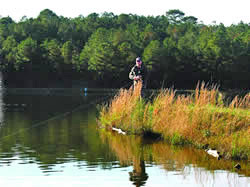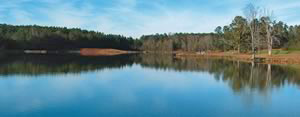An Angler's Paradise Alums Transform S-6 from Eyesore to Pond for VIPs
By: Jamie Creamer

Pond S-6 has become a premiere fishing
spot for CoAg-sponsored events.
Six years ago, the 26-acre site at the North Auburn Upper Fisheries Research Unit was a mess: a massive, abandoned basin overgrown with weeds, brush and tall, scraggly pines and willows.
It was, in essence, an eyesore. Today, those 26 acres are Pond S-6— aka the "VIP Pond"—a sparkling body of water that's teeming with bass and bream and that just might be one of the prime fishing spots in all of Alabama. CoAg alumni and friends know it as the place where they gather to drown a few worms and reel in trophy bass and blue gill during the annual Ag Classic fishing tournament each May. Pond S-6's transformation would not have happened if not for a dedicated group of AU fisheries alumni and faculty who took on restoring that pond as a personal mission born of pride.
S-6 was constructed back in 1946, one of 30 research ponds the Alabama Agricultural Experiment Station built on land north of Auburn that it had bought with money saved on salaries during World War II. The land was purchased from a family named Story—hence the ponds' somewhat unimaginative names of S-1 (for Story-1), S-2, -3, -4 and so on.
The year 1946 was a landmark year for aquaculture at Auburn. It was then, under the leadership of Homer S. Swingle, that the university offered its first formal courses in inland fisheries and aquaculture.
Swingle was not an aquaculturist by training; in fact, he was an AU entomology professor. But he was also an avid fisherman who had grown extremely dissatisfied with the quality of pond fishing around Alabama—a situation brought on no doubt by poor pond management practices.
With his keen interest in and downright fascination with the whole field of aquaculture, he gradually moved from entomology to fisheries and became the driving force behind the creation of the Department of Fisheries and Allied Aquacultures at Auburn in 1970, a department he headed until his retirement in 1973.
S-6, by far the largest of the "S" ponds, was built primarily to conduct long-term bass and blue gill research, a purpose it filled for more than three decades. Throughout those years, though, maintaining that research was an onerous task because of the pond's sheer size.
"Periodically, all the fish in the pond had to be captured and enumerated to collect the data that were needed for the research, and that meant completely draining and then refilling the pond," says Randell Goodman, superintendent of the fisheries unit. "On a pond as big as S-6, that was very difficult."
Eventually, in the early 1980s, then-department head Wayne Shell decided to phase out those particular studies and rethink the research mission for Pond S-6. The result was a plan to divide the large pond into 22 one-acre ponds that would be much more conducive to research. In 1985, Lamar Black, superintendent of the unit at the time, designed and put into motion the renovation project.
"Mr. Black drew up the plans and then got things rolling," Goodman says. "They came in and drained S-6 and started construction, putting in a central drain as well as manholes and individual drains for the 22 separate ponds."
That's as far as they had gotten, however, when funding for the project was cut. The drained pond was basically abandoned for what would be years.

S-6, by far the largest of the "S" ponds, was built
primarily to conduct long-term bass & blue gill research,
a purpose it filled for more than three decades.
Fast-forward to 1999, though, and a group of fisheries alumni, led by Johnie Crance and AU fisheries professor emeritus Rudy Schmittou, who decided it was high time to restore S-6 to the showcase it had been when they were students at Auburn a few decades past.
"The goal was to put the pond back into use, this time as a premier demonstration pond that showed off the best current knowledge about recreational pond management," Goodman says.
Because state or federal dollars to fund restoration of S-6 still were nonexistent, Crance and Schmittou donned their fund-raising caps and started recruiting donations, primarily from alumni, to restore the pond. Though the first dollars in the kitty were proceeds from sales of all the timber cut from the site, the bulk of the remaining contributions came from alumni, who pitched in royally, not only with money but with in-kind services as well.
Goodman cites as for-instances alumni-owned and Auburn-based Southeastern Pond Management Inc., which has provided invaluable input on management techniques, and alumni at American Sportfish in Montgomery County, who have made significant contributions in terms of stocking the pond with bass, bluegill, shellcracker, sunfish, fat head minnows and grass carp.
"The selection of which fish and how many to stock the pond with is all part of the management process for a successful recreational pond," Goodman says.
In the decades since S-6's construction, the field of pond management has undergone dramatic changes, brought on by a transformation of the very nature of fishing itself, Goodman says.
"When the pond was built, people fished partly for recreation but mostly for food, so you had to manage your pond accordingly," Goodman says. "Today, the vast majority of people who call themselves fisherpersons fish for recreational purposes, and nearly all are catch-and-release (anglers). Today, fishing is for the most part a hobby."
As pond management has undergone this major transition, Swingle's guidelines have had to be adapted to that change, Goodman says.
"The management strategy Dr. Swingle developed was directed more at the traditional harvest approach, of catching them to keep," Goodman says. "Everything from stocking rates, liming and fertilizing to supplemental feeding and harvest management has all changed from what it used to be."
As is the case with all the ponds at the North Auburn Fisheries Unit, access to S-6 is limited. So exclusive are fishing privileges at the fabulous S-6, though, that it has earned the unofficial designation as the VIP Pond.
"Only fisheries faculty, students and invited guests can fish S-6 because it still is, above all, a research pond, and we have to maintain proper control of and proper records for it," Goodman says. "Our goal is to protect our research and our investment."
From all indications, S-6 is swimming with potential for this year's Ag Classic fishing tournament, slated for May 5. And just for the event, anglers will be allowed to keep all fish weighing more than six pounds, and for fish nine pounds and up, Classic officials will even have them mounted.
